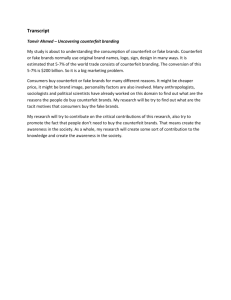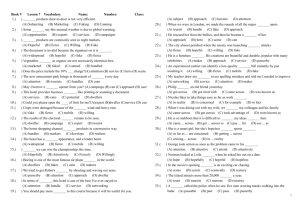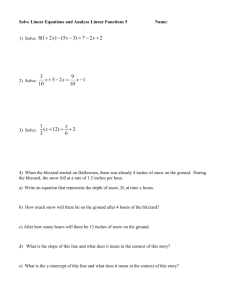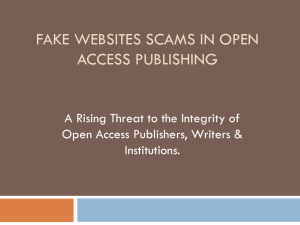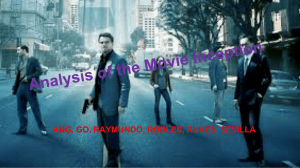DOC
advertisement
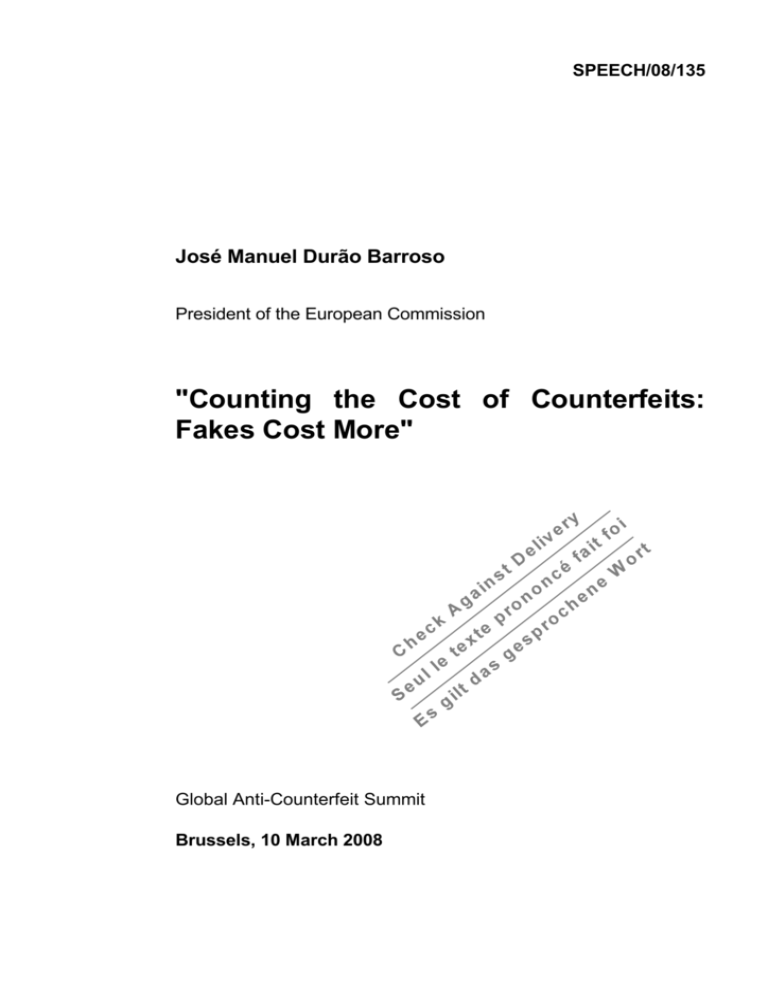
SPEECH/08/135 José Manuel Durão Barroso President of the European Commission "Counting the Cost of Counterfeits: Fakes Cost More" Global Anti-Counterfeit Summit Brussels, 10 March 2008 Distinguished guests, Ladies and gentlemen, I'd like to thank the Authentics Foundation for inviting me to open this Summit. I'd also like to congratulate it for the important work it does in raising awareness of an increasingly worrying – even frightening - trend: the high price consumers pay when they buy fake goods. But first, let me tell you the good news. Thanks to the energy and opportunities unleashed by globalisation, Europe is thriving as never before. Over the last two years, it has created 6.5 million more jobs than it has lost. Employment is at its lowest for the last 5 years. Europe is the largest exporter in the world, and despite the rise of emerging economies like China and India, its share of global exports actually increased in 2006. What is the key to this competitiveness? Certainly not price. In fact it's doubtful whether Europe will ever be able to compete on price again. No, the reason Europe is able to hold its own with premium prices in world markets is because of quality. Because of branding. Because of great ideas turned into great products - from tasty camembert to designer handbags to solar panels using cutting-edge environmental technology. In other words, knowledge and innovation are the keys to European competitiveness. That is why they take centre stage in the EU's programme of economic reform, known as the renewed Lisbon Strategy for Growth and Jobs. I've painted a rosy picture. And there is some justification for that. But there is a worm in this rose: fake goods. Counterfeiting and the theft of intellectual property can do enormous damage to an economy like the European Union's, the sort of economy that relies on quality and innovation. And the days when fake goods meant shifty men with a suitcase full of Rolexes, or teenagers swapping cheap computer games, are over. Today, the OECD estimates that global trade in fake goods is worth around $200 billion – higher than the GDP of more than 150 countries. This figure is rising, and doesn't even include goods that are produced and consumed domestically. And the range of fake goods has increased, too. Fake toys. Fake foodstuffs. Fake electrical appliances. Fake medicine. Fake aircraft parts. I invite you to reflect for a moment on that last example – particularly those of you who came here by plane! The fact is, counterfeiting now takes place on an industrial scale. It has become an extremely profitable business, generating income that can compete with narcotics and weapons trafficking, but at much lower risk. When a kilo of fake CDs fetches 50% more on European markets than a kilo of cannabis leaf, no-one should be surprised that organised crime is getting involved. 2 And the increasing use of the internet to sell fakes, especially medicines, makes the job of customs officials even harder. So too does the increasing sophistication of some counterfeit goods. Some of these now require technical expertise to identify. But they are no less dangerous or unreliable than more obvious fakes. For all these reasons, the European Commission is taking the fight against counterfeiting and piracy very seriously indeed. This is a battle that needs to be fought on two fronts: the supply side and the demand side. Tackling the supply of fake goods requires concerted action in three areas: within the EU, at its borders, and in its relations with third countries. Within the EU, legislation on the enforcement of intellectual property rights was beefed up in 2004, and provides strong civil penalties as a deterrent against counterfeiters. But the European Commission is convinced that in order to fight counterfeiting effectively, we need criminal sanctions in Member States as well. That is why we have developed proposals that would require them to define intentional infringements of an intellectual property right on a commercial scale as a criminal offence. If accepted, Member States would also need to implement minimum sentences, and a range of other penalties that would apply to both individuals and companies, including fines, confiscation of the guilty party's assets, and the closure of premises. Some legal issues complicate this proposal at present, but I am confident that a way forward can be found. Action at Europe's borders is also intensifying. EU customs seized more than 128 million counterfeit and pirated goods in 2006, a jump of 70% compared to 2005. The European Commission and customs have developed new risk analysis techniques and instruments to exchange information to combat counterfeiting and piracy. As recent high profile recalls of consumer products have shown, cooperation between customs and market surveillance authorities can yield excellent results. Industry, particularly brand owners – and I know many of you are here today - can make a real difference by co-operating with customs, in order to protect better their intellectual property. The final pillar of effective supply-side action against counterfeiting activity is cooperation with third countries. And here we have put in place a comprehensive strategy. First, we talked to EU businesses to get a sense of the problem and where we need to act. This confirmed what we already suspected, which is that the vast majority of fake goods intercepted on their way into the EU – around 80%! - are made in China. Also high up on the list is the United Arab Emirates, because so much traffic passes through the ports there, often to hide the true origin of the fake goods. We also identified problems in Russia, the Ukraine and Turkey, as well as in South America and South-East Asia. 3 Then we substantially increased our efforts, creating specific dialogues with key partners, such as China, Russia, Ukraine and several Latin American countries. We are taking a lead in the debate at the World Trade Organisation. We are reinforcing intellectual property rules in bilateral free-trade agreements. We are shifting technical assistance resources to enforcement. We are working closely with industry and establishing reinforced co-operation with countries that share our concerns, like the US, Japan and Switzerland. This reinforced co-operation with third countries is really starting to bear fruit – particularly with the US. Just a couple of weeks ago the European Commission and US Customs and Border Protection announced the results of Operation Infrastructure, which resulted in the seizure of over 360,000 counterfeit integrated circuits, bearing more than 40 different trademarks. It was the first joint operation of its kind, and its value can scarcely be overestimated. Integrated circuits are used in a wide range of applications, including cars, aircraft, computers, telecommunications, medical devices and consumer electronics. Counterfeit copies lack the quality assurance and high manufacturing standards of the genuine article - and as such, experience a much higher failure rate. But despite all this activity, China remains the elephant in the room. Unless we successfully engage China, then everything else we do is a mere side-show. Here too, progress is being made. The Commission recently agreed to develop a joint action plan with the Chinese customs authorities. To deepen our co-operation with China, and pursue work done in the context of our dialogue on a day-to-day basis, we appointed an intellectual property expert to our Delegation in Beijing. This continuous exchange between the two sides is supported by technical assistance on intellectual property, or 'IP'. Last year, the Commission launched a new programme of assistance devoted mainly to IP enforcement. This provides help to Chinese legislative, judicial, administrative and enforcement agencies and institutions. I am optimistic about our chances of success. There appears to be a sea-change in Chinese attitudes on IP issues, and not just because of all our work together. In recent years, the Chinese intellectual property office has risen to become the third largest recipient of patent filings in the world. Between 1995 and 2005, patent filings by Chinese residents looking to protect their own innovations rose by 800%. The Chinese film industry is being crippled by film piracy in China. The Chinese government’s attempts to protect the official branding of this year's Beijing Olympics are being undermined by the flow of cheap knock-offs of official merchandise. Clearly, no responsible government wants the cuckoo of counterfeiting in its nest! Which brings me to the other front in this battle against counterfeiting: the demand for fake goods. As in other areas of the economy, without demand, there would be no market to supply. All too often, consumers knowingly buy faked high street products, thinking that no harm will come from such venial behaviour. As long as they think they are getting a good deal, the trade in fake goods will continue. 4 So let's be frank. Previous campaigns that have tried to frighten consumers by simply focusing on the illegal nature of buying counterfeit goods are not sufficient. The only way we will change consumer behaviour is by raising awareness of the hidden costs of fake goods. And here, the expansion of counterfeiting from a cottage industry to a global business, making forgeries of virtually anything, can help us. Now, we are no longer just talking about poor quality fake T-shirts. We are talking about fake toasters that pose a serious risk of electric shock or fire. We are talking about fake tubes of a major brand of toothpaste which contain high levels of potentially dangerous micro-organisms. We are talking about fake mobile phone toys for infants that contain more than 20 times the maximum limit of 'migratable' lead, which can leach out when the product is sucked or chewed. If anyone thinks I am just scaremongering, this is only a small selection of the products actually seized by EU customs over the last 12 months… IP protection is no longer just a question of safeguarding an economy that relies on quality and innovation. It is no longer just a question of clamping down on crime. It has become a question of consumer health and safety. Of tackling the dark side of product safety. There are no accidents or negligence here, but well calculated criminal strategies with devastating effects on our economies, on our health and environment, on our safety and security. This is the message we have to start sending to our citizens. The role of consumer education is paramount. From early years and throughout their adulthood, consumers should become aware that the choices they make every day shape the world, for better or for worse. Confident and empowered consumers will increasingly demand safe products for themselves and their families, and will eventually start to turn away from fakes. The Commission has made a start. Last summer, nearly 2.5 million diaries were distributed to schools across the EU, with information about what the union can offer young people. It contains a whole section on brands and the dangers of fake goods. We have also developed, in co-operation with institutions of higher education, webbased consumer education tools for citizens in all 27 Member States. These are targeted at consumers in general or trainers. They go beyond the simple provision of general information, to include learning exercises and other interactive material. They tackle basic consumer rights, the advantages of the internal market, and possibilities of redress in case of problems. Again, the risks of counterfeit goods feature prominently. But more needs to be done, and organisations like the Authentics Foundation have a crucial contribution to make. Ladies and gentlemen, The time has come to educate consumers about the true cost of counterfeit products: the damage to our economy and our future; the organised crime; the child labour and appalling work conditions that often lie behind such products, the risk to consumers' own health and safety. In the end, the message is clear: fakes cost more. Thank you. 5
